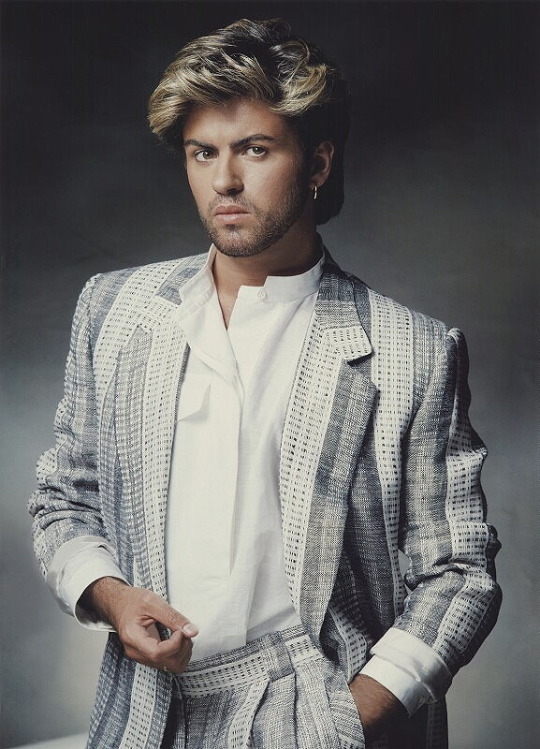Note
could I possibly have your name? I know this sounds sketchy but I'm writing an essay on MJ's music video 'they don't care about us' and I love your analysis. i want to list you as a source and need to reference correctly so ill need a name
Hi there! Thank you so much for taking the time to read my article! Of course you can list me as a source. If you’d like to mention my name, you can use the name of my blog funknroll.online! If you’d like, when you’re done with your work, you could send it over, I’d really love to read it! :) Thank you! G✨
9 notes
·
View notes
Text







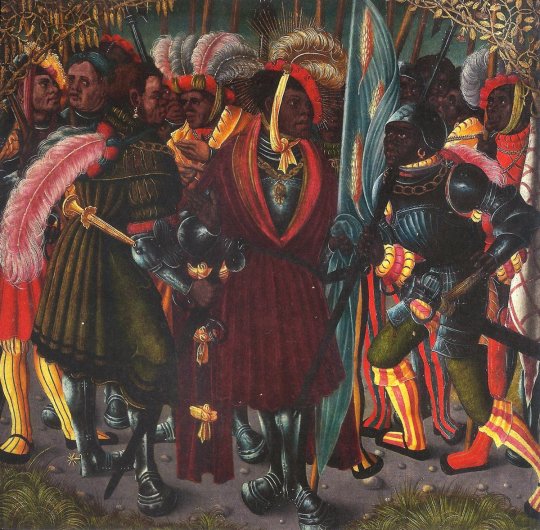
The first statement is definitely true as I've shown many times.. This in contrast to the last pic where after they whitewashed us out of history they would symbolize us by being devils instead which is the opposite of how black in Europe use to be viewed
1K notes
·
View notes
Text
Teach your fucking sons that women don’t owe them a fucking thing
324K notes
·
View notes
Photo
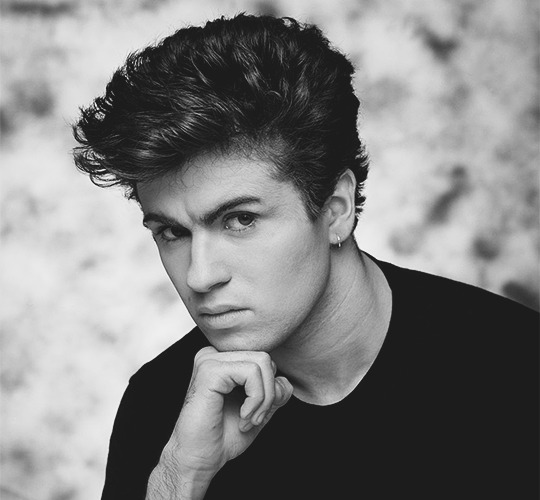

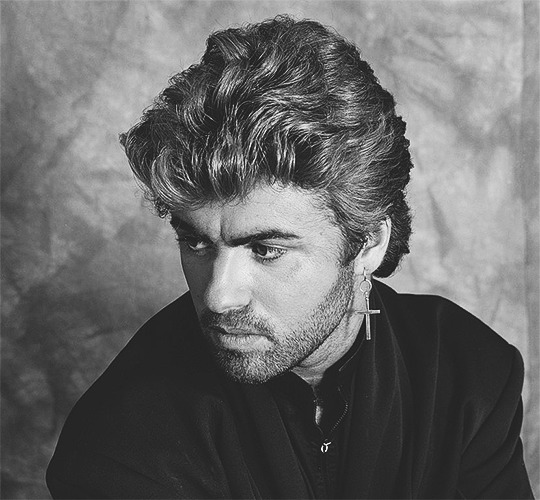
Rest in Peace, George Michael (June 25, 1963 - December 25, 2016)
2K notes
·
View notes
Text

To all my music lovers, follow me on Instagram @/music_addiction_ig if you’d like!! I’m more active on that app! And if you want to stay up to date, you may follow me there!! I promise, you will not regret it!! Thank you!! Peace! Be safe. G💜✨
#music addiction#music#music icon#music blog#great artists#articles#instagram#blog#blogger#suggestion blog#music lovers#musicenthusiast#writer#reblog#article#good music#music history#musicians#musicphotography#music news#musica#iconic#music legends#great music#follow me
1 note
·
View note
Text
Michael Jackson's They Don't Care About Us: The relevancy of the unmatched protest-masterpiece still actual today.
They Don't Care About Us, was perhaps the most monumental and relevant form of audiovisual protest, which force was specifically to draw the attention to social and political issues such as hate, racism, prejudice, police brutality. The form of art is cultivating an ideological allegiance with the greater social plight for minorities. With his art, Michael became the voice of the voiceless, of the oppressed, of the neglected, of the abused. Yes, Michael Jackson was THE voice.
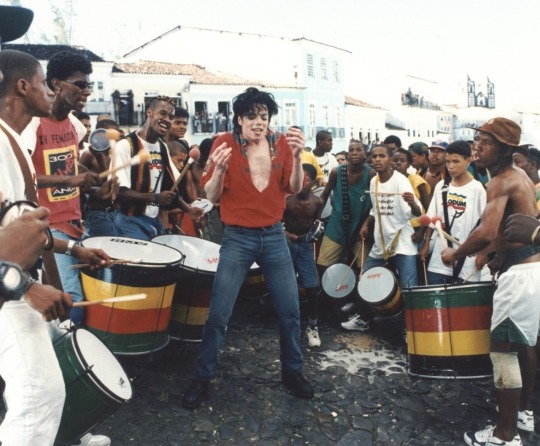

Hi music lovers, today's topic is Michael Jackson's They Don't Care About Us the song and the music video.
It was from September 1994 to March 1995 that Michael recorded and released HIStory, his 5th studio album. The work was one of the artist's most personal artistic outputs, where music turned into a mirror reflecting Michael's deepest sorrows, fears, anger, and frustrations. It was then when Michael let his music speak louder, providing a perfect clap back to all those who questioned and speculated. The album was a double-disc of greatest hits, HIStory Begins, and new material HIStory Continues.
Speaking of They Don't Care About Us, it is the second track on HIStory Continues, following Scream and precedent to Stranger In Moscow. The song is a straightforward response to the ruthless and ubiquitous injustices perpetrated upon him and more in general upon black people by the racist forces of the white cultural hegemony. Extremely compelling is the aura of pure rage and frustration articulated in They Don't Care About Us, both in the record and in the two poignant and groundbreaking music videos (The Prison version and the clip shot in Brazil), released to accompany the track as a single.
Personally, when I began to approach Michael's music, I did not quite understand the real deep meaning and message the song was delivering. However, as I grew up, I developed interest and curiosity regarding the significance of this timeless masterpiece. Particularly the visual interpretation caught my attention. Hence, this article will entail the information I found through my research. The two videoclips released, were, and still are, wildly exhaustive pieces of art, expressly crafted to challenge our very seldom corrupt societies, people's beliefs and mindsets.
Moreover, in these short movies, the artist did not miss the chance to channel his frustrations and rage through his distinct blueprint that turned everything he did into pure gold. There is a broad range of aspects that compose the audiovisual endeavors that are worth discussing. These elements comprehend the lyrics, the human rights violation, racism, and social injustices; all these perspectives are the fulcrum of the whole work. The acute and fierce language contributed to making the artistic output more impactful.
It is now interesting to also analyze They Don't Care About Us from a Post-Colonialism theoretical standpoint. Firstly, for those not familiar with the Post-Colonialism theories, it is a study of all the effects colonialism had on cultures and societies, concerning both European countries, that brutally conquered other nations, and how the lands and populations won responded and most importantly resisted those invasions and trespasses. Furthermore, the study of Post-Colonialism as a body of theory has and is still going through three major stages. The initial one entails the first phase of awareness of the social, psychological, and cultural unjust condition of inequality and exploitation, enforced by being in a colonized state. Secondly, a struggle for ethnic, cultural, political, and economic autonomy begins. As a consequence, there will be a growing awareness of cultural overlap. Eventually, I would say that some of the post-Colonial elements are quite evident in the two music videos.

The song and the two music videos are eloquent protests against racism. Michael speaking in the first person gives a platform to all the voiceless minorities, offering an accurate and poignant depiction of their conditions of merciless oppression, that stripped minorities of their humanity, pride, and most importantly their rights. Related to the concept of racism, with a simple yet efficacious line, Michael addresses the still hugely relevant and actual issue of police abuse and brutality, which is the central theme of the Prison Version short movie. The artistic output was magistrally filmed by the genius Spike Lee, in a real prison in Queens, New York. The opening sequence shows black schoolchildren standing behind a wire fence in the snow, chanting the chorus of the song, providing a visual accompaniment to the introduction we hear on the record. As the beat kicks in, the scene displayed is quite impressive and provocative, because it employs a poignant and immaculate montage of explicit documentary footage.
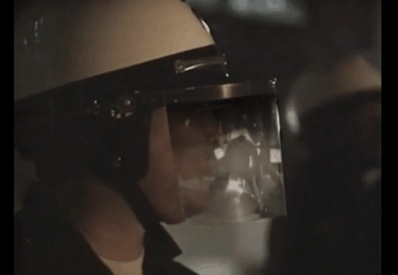
The clips complementing the short film are retrieved from the footage of the Rodney King beating and subsequent LA riots and the brutal police beatings of African American people. We then witness the swell of an atomic mushroom cloud, followed swiftly by footage of a Japanese child sitting alone and crying amid a devastated Hiroshima. Alongside, we see a close-up image of an African boy face swarming with flies, then the assassination attempt on George Wallace. Subsequently, come on the screen, some pictures of the student rebellion on Tiananmen Square in China, and finally some footage from the Vietnam War. All these footages contribute to making the video so harsh to the point of getting the audience uncomfortable. In the scenes taken in the cell, Michael appears to be haunted by the ghosts of beaten people.
his film stands out for its immediacy and accuracy, yet these clips do not incite destruction nor hatred, but rather the opposite. Indeed, those footages are stressing compassion, a peaceful reaction to a hurtful and horrible situation, and political reunification. Thus, this is another reason why there is not even a trace of violence or sign incitement to hatred or aggressive reactions. Those were not merely television images, but real-life pictures of a horrid reality of human humiliation, abuse, and suffering that sadly surround us everywhere, that break into our everyday lives through television, social media and computer screens. In the video, the tension is palpable yet, the revolt is peaceful and not suppressed by the guards. However, Michael openly expresses his anger with demonstrative insolence. For instance, he sweeps tableware off, hits a guard's baton right in front of his face. Interestingly, the artist is the only prisoner who moves freely and around the dining room, demonstrating against the disregard for human rights and laws by authorities. During the whole short film, Michael tries to convince people to fight for their rights, raising the spirit of protest against oppression and humiliation.

However, in reality, prison riots never end with prisoners slamming fists against the tables or dancing on top of them and, Michael was very well aware of it. The last scene of the video shows the artist free and running up the stairs, glancing back, running away from the penitentiary in a Brazilian favela (might this be the red thread that connects the first short movie with the second video?) while his scream still lingers in the air … Leaving eventually an open question which is asked through ASL American Sign Language: "I don't know what lies ahead… Where will this spirit of struggle lead me, where will it further manifest?" This part honestly gave me chills!


The second version of They Don't Care About Us was shot in Brazil in February 1997, precisely some parts were filmed in the central district of Salvador de Bahia. The footage where Michael is wearing the iconic Olodum t-shirt and dances with Brazilian people was taken in a favela in Rio. However, for the artist, it was quite a struggle to manage to shoot the short movie in Brazil because the local authorities intended to prohibit the filming, expressing their dislike for the project, given that it would have shown the country in an unfavorable light. Yet other authorities approved the project because it would have been an influential means to draw the world's attention to the condition of poverty. Thus, the region might have benefitted from having such a big platform offered by one of the most prominent artists on earth. However, after the Brazilian government allowed to film the video for 20 days, it changed its mind abruptly and reduced, vastly, the filming period to 5 days only. The Brazilian version opens with a girl speaking in Portuguese saying: “Michael, eles nao ligam pra gente.” which means “they don’t care about us.”, then showing the whole favela with an aerial shot. Eventually, Michael gets out of a door and starts performing.


Although this version is still impactful and manages to deliver the message impeccably, I would say that it presents some fundamental differences from the so-called prison version. Indeed, even though some policemen who look stern and indifferent are part of the short movie, in the Brazilian clip, the atmosphere is quite different from the previous one. As a matter of fact, the festive whirlwind of colors, rhythms, and dances are what reminds the audience of the social meaning of the song.
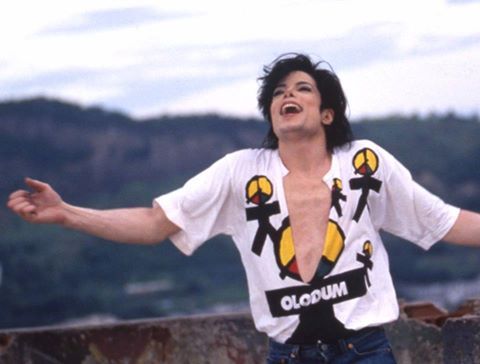
Furthermore, the vivacious and colorful performance is backed by members of the local cultural and musical group: Olodum. The organization was and still is of particular importance as one of its primary purposes was to combat racism and help cultivate a sense of self-pride and affirmed identity among the Afro-Brazilian community in the region. The organization as well provides a springboard for the promotion of civil rights on behalf of all marginalized groups. Hence, it was not a mystery the reason why Michael was aligned with Olodum, to the point that he supported the organization by wearing their merchandise in his short movie. The display of solidarity was reciprocated, through the act of the collective performance of the group’s musicians who contributed with an additional layer of live percussions and vocals, over Michael’s original studio recording.
Moreover, the language as well plays a fundamental role in this creative output. Indeed, the lyrics and the whole message delivered with this piece were not exuding revenge or aggressiveness, which were typically used to fuel accusations and rage. Au contraire, the song is the manifestation of the indignation and the energy of resistance, empowering self-control and fortitude against repressions. Hence, I would say that the song does not contain a single trace of aggressiveness, and its content and energy stay perfectly within boundaries. The language and expressions employed to address the issues are particularly relevant to explain the horrid effects colonialism and post-colonialism have had on the populations affected and thus to protest against the neglect of fundamental human rights.
Furthermore, it is interesting to point out that the element of the language expresses the manifestation of spiritual endurance and disobedience against the oppressors and lying accusers immaculately and, therefore, the dualism between the artist singing in the first person and the "Us" contained in the title and refrain of the song. Although TDCAU is addressing some social and political injustices, it may as well be true that Michael has attempted to convey his frustrations and anger in this piece, turning them into a timeless audiovisual work of art. Arguably, this could as well be the reason why the artist decided to release two variants of the short movie, the prison video featuring a crude and powerful documentary and the flamboyant, colorful Brazilian clip.
Furthermore, another element related to the Post-Colonialism discourse is how the artist and more in general black people and minorities are very seldom victims of unjust and appalling stereotypes that are addressed in the line “Don’t You Black Or White Me". This brief but straightforward segment of the song could be subjected to double interpretation. On the one hand, there is Michael Jackson, a man, a human being, a son, a brother, a father, a friend, who from the day he was born was put under the magnifying lenses of the whole world, his audience and tabloids. Most of the times he was judged, wrongly, bullied I would say, to the point that he could not even enjoy his life anymore without the anxiety of being abused, ridiculed and humiliated by people who did not take a second of their lives to do their research on his works, life, and what he stood for. Therefore, this line, specifically, is how the artist expressed his frustration towards those utterly racist reactions towards him. On the other hand, Michael decided to extend this statement to a broader scale, becoming the brave advocate who gave voice to all the voiceless people who were victims of racism, prejudice, ignorance in all their nuances and degrees.
Moreover, as Michael responded to the critiques received for the straightforward and sharp lyrics during a press release for the New York Times in 1996 " The song, in fact, is about the pain of prejudice and hate and is a way to draw attention to social and political problems. I am the voice of the accused and the attacked. I am the voice of everyone. I am the skinhead, I am the Jew, I am the black man, I am the white man. I am not the one who was attacking. It is about the injustices to young people and how the system can wrongfully accuse them. I am angry and outraged that I could be so misinterpreted." He was the voice of the angry and outraged voiceless.
To conclude, They Don’t Care About Us with its first-person narration, the refrain, and the two iconic music videos, the socially and politically challenging lyrics and message, relates to the problems minorities face every day. They don’t really care about us means they, the society, privileged white people, the governments, do not care about the minorities, about the voiceless who have been abused, oppressed, robbed of their rights. They don’t really care about the people. The challenging lyrics and footages in the prison version offer us a chance to reflect on the importance of these topics. Not to mention the actuality of the song, which is remarkably accurate and relatable to the modern world and times we are living in. This artistic output is the greatest, most compelling and influential statement against every injustice perpetrated against all human mankind, and will forever be part of Michael's and the world's legacy. Therefore, the questions my reflection generated are: is this the world we want to live in? Are these the world and the society we want our children to grow up into? Is this the world without prejudice, ignorance, abuse, oppression, no equality, and equity we want for ourselves? And for the white folks like me: are we using our privilege wisely, to uplift, amplify the voices, the needs and wants of our brothers and sisters who are part of minorities and are facing some serious major struggles and discomforts? As Michael asked at the end of the short movie: “ I don’t know what lies ahead… Where will this spirit of struggle further manifest?”
Reflect deeply.
Thank you for your attention💜 Peace. G✨
#michael jackson#michael joe jackson#king of pop#kingofpop#they don’t care about us#brazil#prison#protest songs#olodum#music#music icon#music blog#black excellence#iconic#music legend#great artists#genius#article#mjfam#mjj#mjinnocent#mj icons#history#album#pop#protest#protect black lives#black lives matter#police brutality#injustice system
138 notes
·
View notes
Text
CHLOE X HALLE "UNGODLY HOUR": A JOURNEY THROUGH SELF-AFFIRMATIONS, VULNERABILITIES, STRENGHTS, PERSONAL AND ARTISTIC GROWTH. THE GEM WE DIDN'T KNOW WE NEEDED
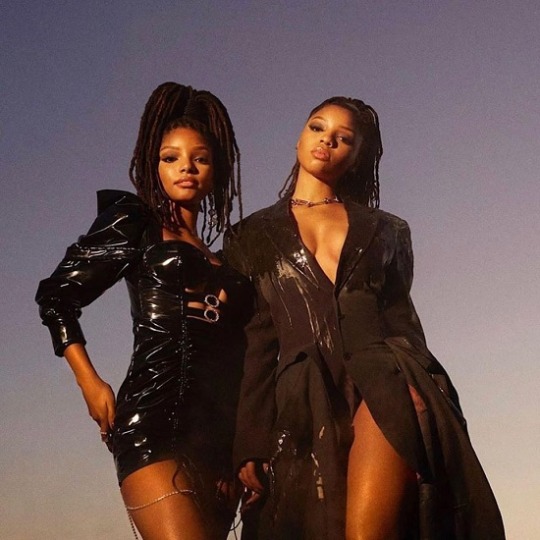
Despite all the traumatic things that happened this year, summer 2020 is full of great new music we are totally in love with. One of the new albums that caught my attention is Ungodly Hour by the powerful duo Chloe x Halle. With Ungodly Hour, the Bailey sisters mark their coming of age, exploring a more adult territory. The new R&B record is indeed drenched in sultry harmonies, intricate beats, ravishing vocals, profound, empowering, at-times caustic lyrics.
The album was released one week later in solidarity of the Black Lives Matter protests and boasts the writing and production credited to the two sisters. With no further ado, let's discuss this new gem. A 28 seconds Intro opens Ungodly Hour with Chloe and Halle harmonizing together on the melodies of the next songs, then stating, "Don't ask for permission, ask for forgiveness." which sums up the whole concept of this work. Forgive Me with the melancholic harmonies accompanied by meticulous vocals and downtempo beat, is the perfect sorry-not really sorry breakup song in the face of a jerk who stole time with his lies and empty promises. As the artists sing in the previous song, "Best believe I move onto better things," the next track Baby Girl finds the pair moving into a new scary yet exciting new world full of adventures and independence. The complex and layered beats masterfully crafted by Chloe perfectly match the lo-fi harmonies. Segueing the laid back, vintage-flavored Do It is one more time about being independent, partying, having fun, not-"looking for boo," having a no drama mama kinda night. In Tipsy the straightforward biting lyrics, and the angelic vocals match the themes of the song excellently, "Better babe, you better treat me better (babe)/ Better than those other guys who change up like the weather,/ It is such a shame that they went missing, they can't find 'em now/Oh, I wonder how, I accidentally put them in the ground? Yeah". As we can see from these words, this is another sorry not sorry advise for a boy to not play with fire or else... Then the gorgeous 80s-verved title track is a perfect mix of infectious house beats and alluring vocals. Opening in a terrific soul vocalization in the taste of the glorious Motown Records and the Supremes, the classy R&B Busy Boy is ornated with gorgeous vocal complexities shifting from low notes to higher ones. One more time, the lyrics of the song are a metaphoric middle finger spurred in the face of a typical annoying "I know I can play with any girl I want" fuck-boy. Not this time, Kevin. Chloe and Halle don't want your unsolicited nasty pictures. Chloe and Halle didn't come here to play with you this time!! Next song the stringed-based with prominent hip-hop beats Catch Up boasts the collaboration with part of the hip-hop duo Rae Sremmurds, Swae Lee, and Mike Will Made-It, who also helped in the production process. What is impressive about this track is how the voices of the four artists work in perfect harmony with one another. Subsequentially, Overwhelmed is a short yet expressive piano-based interlude accompanied by gorgeous almost-acapella angelic voices polyphonically set, which works perfectly with the central themes.
With Overwhelmed, the duo addresses the feeling of helplessness exploring and diving into the deep vulnerabilities youth brings: feeling like not having everything figured out while the pressure keeps pushing, ultimately not knowing what to do and how to fix things "I don't know at all/ I wish I had all the answers/ Fix it all myself (oh)/ I feel overwhelmed." This is what the stunning interlude is all about: everyone can surely empathize with these genuine words. We all have been there. At least once. With Lonely, the duo gets back to the classy, insistent R&B beats, delving into the art of being alone as a moment and act of self-discovery, self-love, because after all, "It don't have to be lonely being alone." Segueing Don't Make It Harder On Me, is a sumptuous Motown-tinged, Never Can Say Goodbye by Jackson's 5 flavored with a touch of It Ain't Over 'Till It's Over by Lenny Kravitz, glistening sampled-stringed ballad. Wonder What She Thinks Of Me is yet another emotional stringed power ballad nestled with utterly striking and precise vocals. Closing the album ROYL, an effervescent anthem with trap beats resembling Lizzo's iconic anthem Truth Hurt. With this song the duo aims to remind themselves and the listener the uplifting truth, "You wanna fly, but you don't/ You holdin' on your wings/ Look to the sky, why don't you/ Live for the finer things?/ You know, you know, you know that you fine like that". Because to spread our wings and fly, we need to stop holding onto our wings and live, right?

With the superb, classy, and always precise vocals, its masterful production and empowering lyrics, Ungodly Hour is a beautiful not-always-comfortable voyage through the self-affirmations, ethos, vulnerabilities, strengths, of Chloe x Halle's personal and artistic growth and the passage from teenagerhood to womanhood. In the album, the protective layer of innocence dissolves, unraveling the artist's ending in approaching love naively, in turn sparking their awareness on the dangers of the lies and subterfuges deeply ingrained in it. There is so much strength and so much power in togetherness and sisterhood. There is so much empowerment from the two siblings whose constant message is to remain unapologetically true to themselves, being proud, gorgeous young women. Not only did the duo create Ungodly Hour to empower themselves. This work was, as well, conceived as a common salvific act for other women to relate to the artist's message. They really "Did It For The Girls." Ungodly Hour represented one of the first adult acts from the astonishingly talented duo, and I cannot wait to hear more from Chloe x Halle, and I am sure we will. This was just the beginning of a bright future awaiting them.
Thank you for your attention💜 G✨
#chloe x halle#chloe and halle#ungodly hour#album review#new music#new album review#recommended#girl power#black girls magic#appreciating black artists#black music month#intersectional feminism#Women empowerment#empowering women#Female Empowerment#black female artists#music#music blog#article#women empowering woman#forgive me#for the girls#reblog#black excellence#black queen
38 notes
·
View notes
Text
FOCUSING ON JANET JACKSON: THE STORY OF THE ICONIC LEGEND, THE HIGHLIGHTS OF HER SUCCESSFUL CAREER, THE FIERCE AND INSIPIRING MESSAGE DELIVERED THROUGH HER TIMELESS ART
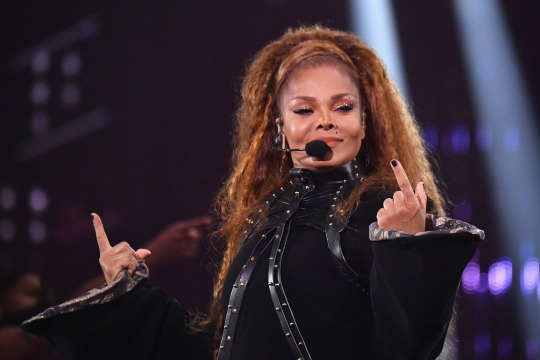
Hi music lovers, today I’m focusing on Janet Jackson, I tried to cover as much as I could with this article. Just know that I will write other articles about her, therefore if you do not find some particulars in this essay, just know that they will be in another future article!! I hope you enjoy this article💜
For 54 years the music icon “Miss Jackson” has and still is paving the path for many artists and inspiring us all with her legacy, talent, grace, and beauty, being the role model everyone should look up to. Today I am focusing on the highlights of Janet Jacksons extraordinary career.
Born Janet Damita Jo Jackson on May 16, 1966, in Gary, Indiana, the artist, was the youngest of ten children, but undoubtedly not the least talented. Indeed, at the young age of 10, she got the part of Penny Gordon on the tv show Good Times and her acting skills were already showing. The young child prodigy also made a few memorable appearances on the tv show Diff’rent Strokes as Charlene Dupree and soon got her role on the renown show Fame as Cleo Hewitt. Though the show business was not all flowers and roses for young Janet, who, even at the age of 10, was already showing her iron will to achieve the very much desired success. Indeed, as the artist recalled, “‘I would set my alarm clock for 5.30am, get myself dressed, and get myself out of the door for work five days a week,’ she says. ‘And for a 10-year-old to have that kind of discipline – there’s a lot to be said for that.’.
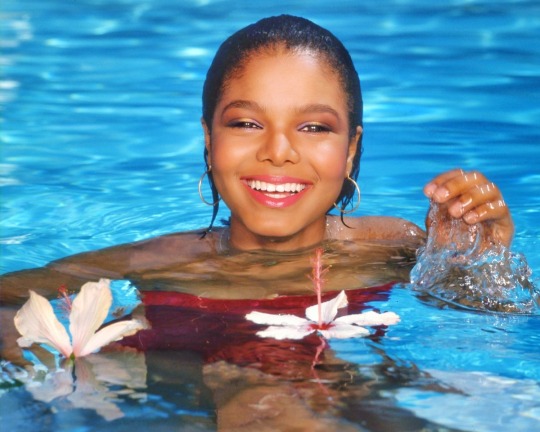
Then Janet decided to pursue the music career in the 80s, establishing herself as a singing star of the first order. At the age of 16, she dropped her first self-titled album. The pop, funk-influenced, fresh, and danceable record was the beginning of a glorious and remarkable career. Young Love even reached number six on Billboard’s R&B chart. The following year the artist issued Dream Street. The exquisitely pop album was entirely in the fashion of good 80s tunes. Not to mention the surprise guest artist who lent his signature voice in Don’t Stand Another Chance and All My Love To You.
However, in 1986 came Janet’s commercial, and most importantly, creative breakthrough. The artist teamed up with none other than Minneapolis-based producers Jimmy Jam and Terry Lewis to create Control, the game-changing, legendary R&B-pop masterpiece that paved the way for the new emerging sounds of the late 80s. Through the empowering lyrics, the artist declared her independence with passion and grace as she affirmed in the title track, “this time, I’m gonna do it my way,” and she really did it. Moreover, the pure brilliance of this work lies in the extremely self-assured vocals and sleek slamming beat combo that presented Janet as a confident tough-minded artist who is in charge of her life and her choices. In support of her brand-new persona, Jam and Lewis crafted a set of gleamy, computerized hip-hop-nuanced funk and urban R&B backing tracks. The album eventually sold over 5 million copies, establishing Janet as a new influential pop star and role model. With this album, the artist was already showing her immense talent.

In 1989 the artist teamed up again with producers Jam and Lewis and released the hotly anticipated follow-up concept album: Rhythm Nation 1814. With this work, the artist became more overtly political, exploring socially conscious themes and issues, which were the whole fulcrum of the album. The singer took some risks with this Rhythm Nation as protest songs were quite uncommon in R&B, but making those risks paid off as the masterpiece not only assured Janet an even higher artist plateau, but it also had wildly successful results. As the artist sang in the title track “Join voices in protest to social injustice” or “A generation full of courage, come forth with me,” in this work, Janet explores themes such as racism, sexism, and feminism and flourishing as a person and artist in an environment ruled by both issues. However, some nonpolitical songs could not miss, ranging from smooth and silky ballads such as Someday Is Tonight, Alone and Come Back to Me to the pop rock influenced Black Cat, to the funk-influenced Miss You Much and Alright to the bright and romantically-themed Love Will Never Do (Without You) and Escapade. The album was a triumph and was accepted enthusiastically by the audience. In support of this masterpiece, Janet undertook her first tour, and it was a smashing success.
In 1992 the artist, along with rapper Tupac Shakur starred in John Singleton’s all-time classic, Poetic Justice. Janet gave proof one more time of her extraordinary acting skills taking up the role of Justice, a hairdresser, grieving over her boyfriend’s death, who writes poems to get through the sorrow of her bereavement.

Subsequently, 1993 saw the artist fully embracing her sexuality, which was crowned with her breakthrough homonymous album: Janet. The new image was trumpeted with a strikingly iconic Rolling Stone cover picture: an uncropped photo with the artist topless covered by two hands. The picture was then used as the album cover. One more time, Janet teamed up with the iconic duo Jam-Lewis and the outcome churned out did not leave the audience disappointed at all. The powerful trio left the synthesized funk in favor of warm, gently, inviting undulating grooves. The 28 tracked album is the product of the artist’s groundbreaking eclecticism. This masterpiece is a perfect mix of whooping cuts sprawling a sonic extravaganza where only 12 were proper songs, and the rest short interludes. The new quirky sounds were aligned perfectly with the brand-new public persona the artist created. The album shifts from the old school shuffle-beat-pop of Whoops Now to the New Jack Swing of You Want This. The leading guitar of What’ll I Do is a 60s flavored old school-rock hit with a bit of Janet’s signature sound. The danceable grooves of Funky Big Band are spiced up with old-jazz samples, while the erotic moans in Throb are a clear nod to Donna Summer’s Love to love you, baby, with some electro-trance influences I must say. A major sociopolitical hit could not miss on this masterpiece. The pop song New Agenda featuring a noteworthy cameo from rap Public Enemy’s head MC. Chuck D is indeed touching some relevant themes such as gendered racism and sexism, which issues were and still are much present in today’s society. The album is also featuring some enjoyable ballads such as the major hit and R&B Again, which appeared at the end of the movie mentioned Poetic Justice. With The Body that Loves you, Janet shifts to some jazzier, smooth, and silky sounds, while the slow R&B-nuanced Any Time Any Place is a groovy erotic jam. The angry This Time is a successful experiment in mixing rocky inflections with lyrical singing. The centerpiece was the album’s first single, the groovy alluring infectious ballad That’s The Way Love Goes. Not only is the collection a groundbreaking masterpiece sprinkled with revolutionary sounds, but what is striking most about this work is the intention with which it was produced. Indeed, Janet is a clear statement and frank celebration of female sexual liberation, which was and still is considered a taboo topic. Through this album, Janet explores black sexuality and lust, which is something black women have always been stereotyped about. Hence, with the explicit lyrics, the mellow and groovy sounds, the artist unveils these relevant topics making a monument to black lust, ultimately taking the power of her own sexuality back, which is portrayed as a beautiful, liberating act. With this masterpiece, Janet was baptized as one of the first real trailblazers and role models who paved the path for multiple African American female artists in addressing and embracing their sexuality fully. Additionally, the video of If was praised for being a beautiful, uplifting celebration and portrait of interracial lust.

Furthermore, how can we forget when Janet introduced her legendary brother Michael at the 35th Grammy Legend Awards on February 24, 1993? The artist wearing a gorgeous total white look and matching high heels matched Michael’s nestled pearls jacket. Not to mention her iconic, memorable hairstyle: beautiful box braids slicked-back into a high ponytail topped off with a had-band turned ponytail-holder matching the whole outfit. The jewelry was also in harmony with the outfit, as the artist opted for silver medium hoops (which went gorgeously with the hairstyle), a classy silver chained necklace, and of course, a couple of silver rings. Janet stepped on stage with the biggest, brightest, and most gorgeous smile to introduce her brother with one of the most touching speeches ever, beginning with “Before he won 12 Grammy Awards before he dazzled millions of fans around the world with his amazing talent as a performer. Before, he impacted millions of lives with his ongoing humanitarian efforts. Before all of that, he was one other thing, he was my brother”. Then she presented the audience an enlightening book of the instructions on how to become a legend choosing Michael as a guide. But the best part was yet to come. Indeed, Janet expressed her love and gratitude for her brother, and honestly, she had us crying the ugliest tears ever and Michael too “I just want to say one thing, seriously. I just wanted to tell you how proud I am of you and how much you’ve inspired me and how proud I am to be your sister. And how much I love you, I do”. It was lovely seeing Janet and Michael sharing a beautiful moment on stage and joking with each other. It was indeed a beautiful, heartwarming moment to witness.

In 1995 Janet’s came in support of her brother Michael in Scream, the lead single contained on the album HIStory. The duet between the younger sister and Michael finds the pair spitting out tightly wound lines railing against tabloids. The industrial beats and clattering percussions encased an incredible one of the most mind-blowing vocal performances ever. The sense of frustration and rage makes it one of the most vivid and enduring songs. Not to mention the iconic video directed by Mark Romanek housing the siblings in their own hyper-modern spaceship complete with an indoor zen garden, remote-controlled art gallery, and futuristic squash court. The iconic video came in black and white, with the spacecraft flying over the earth and Michael standing in his distress capsule. Then the tv screen flickers and Janet closes her eyes in the distress capsule. A deafening noise reverberates through their headphones, and the siblings scream in pain. An anime comes on tv, and Michael breaks the glass of the capsule. With this intro, the legendary duo begins a mesmerizing and extremely arduous choreography in unbelievable perfect sync with each other. Not to mention the iconic outfits consisting of black and silver PVC pants, silver bikini for Janet, and black or grey spiked shibori crop-tops styled by David Bradshaw.
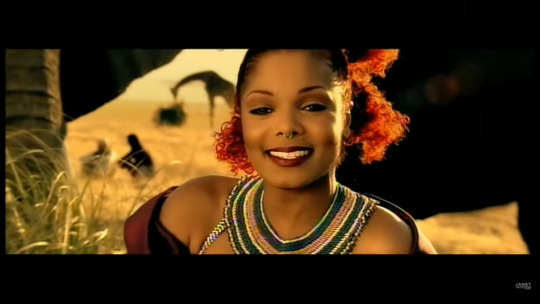
In 1997 came Janet’s follow-up album, The Velvet Rope, representing the product of her artistic revolution. With this album, the artist is summarizing the essence of the three previous works: the self-empowering messages from Control, the skin-deep social consciousness of Rhythm Nation, and the sexual liberation of Janet. Through the mature and experimental new sounds, the artist takes the listeners on a journey through the exploration of her psyche and sexuality: the outcome leads us to a darker path than the previous works released. Indeed, the singer sought to combine the sensuality of the last record to some more socially conscious parts such as domestic abuse, AIDS, and homophobia. Indeed, Vanessa-Mae’s prog-rock violin solo on the title track is setting the tone for profoundly spiritual work. The bass-heavy house track Together Again was an elegy for AIDS victims, which showcased a poignant vocal and lyric. Furthermore, from the raw and extremely vivid words of What About “What about the times you hit my face?../What about the times you said you didn’t fuck her; she only gave you head?” it is quite clear what the song is dealing with. And the anti-homophobia song par-excellence Free Xone shifts the moods and tempos segueing from a Prince’s Love Symbol (if you know what album I am talking about) like jam to an intriguing masterful sample from Archie Bell and the Drells’: Tighten Up. Extremely popular on the radio was Got ‘Til It’s Gone featuring the rapper Q-Tip and a reggae-crafted beat of Joni Mitchell’s Big Yellow Taxi. I Get Lonely featuring Blackstreet was another tremendous hit that traversed the dark side of desire. Then Every Time is a melancholic piano-based touching ballad (not going to lie this song had me crying ugly tears!!). The edgy rhythms and he drum-and-and-bass lite in Empty are enhanced by Janet’s delivery racing in a staccato. Then the smooth groovy slippery Go Deep is worthy of some of the best Michael Jackson’s jams (can you notice the resemblance with some of Michael’s songs?). Special is another fabulous piano-based ballad drenched in meaningful lyrics, a true anthem of self-worth-discovery delivering an essential lesson “You see? You can’t run away from your pain. Because wherever you’ll run, there you will be. You have to learn to water your spiritual garden. Then you will be free.”. The idyllic song is abruptly stopped halfway by Janet saying “work in progress,” because after all, we are all a work in progress in our journeys through self-discovery and self-love, right? In the second part of the song, the hidden track “Can’t Be Stopped” is a monumental celebration of being Black where the artist is encouraging other African-Americans to have the same pride “You were born with blood of Kings and Queens and can’t be stopped.” Furthermore, through interludes such as Sad and Memory, the artist explores her deepest emotions and grief. For instance with the few words of the album opener Twisted Elegance “It is my belief that we have the need to feel special/And its this need that can bring out the best in us/Yet the worst in us/This need created the velvet rope” Janet is putting into a small number of words the whole purpose and meaning of this monumental masterpiece. The Velvet Rope is, in fact, a metaphor for a place deep inside. We all strive to protect where all our feelings and thoughts lay. Janet, with this album, is courageously unveiling her Velvet Rope, letting herself firstly and the listener beyond it directly into her sacred “spiritual garden.” Indeed, it is not a mystery that the singer chose the symbol of the Sankofa ( which is also the symbol of the Adinkra tribe in West Africa) to represent the album. Indeed, its paraphrase means “You must learn from your past to move forward,” and this is again the whole concept of The Velvet Rope.
In 2000 the artist appeared in Eddie Murphy’s comedy The Nutty Professor II: The Klumps as professor Denise Gaines.

The next year, on March 12, 2001, the artist was honored with the MTV Icon Award, where the glittery talent roster included Beyonce and Destiny’s Child, Stevie Wonder, Aaliyah, ‘Nsync and Macy Gray, to pay their tribute to the legendary icon. To keep the hype of her new upcoming album release, Janet performed All For You the title track of her next album due on April 24, 2001. The singer ascended the stage in a gorgeous stylish all-white outfit and blew the audience away with her enchanting voice and impeccable choreography. After the performance was over, the artist thanked her dancers and her fans, saying, “It’s such a special night in my Life. An amazing night. Thank you so much. Because of you guys, I’m here. Thank you. I love you.”. Needless to say that we love our beautiful, humble queen more.
Moreover, after the super-personal and provocative Velvet Rope, Janet teamed up again with Jimmy Jam and Terry Lewis to produce the sparkling danceable 70s/80s-influenced All For You. Come On Get Up (one of my favorite tracks in the album) breaks into a frenzy dance upbeat tempo and synth followed by some joyous and impeccable vocals. When We Oooo is an R&B downtempo percussive-based groovy alluring ballad that takes us to another dimension. The R&B ballad China Love is characterized by an extremely neat yet unique instrumental. The sounds of traditional Oriental chimes delve into the past love connections and other new age ambiguities. The glossy, silky slow ballad Love Scene is a sensual jam, perhaps one of Janet’s sexiest song in the album. Trust A Try is the product of a collaboration with hip-hop producer Rockwilder. The monumentally theatrical vocals are accompanied by a reinvention of the opera-genre rearranged into the rock key with electric guitars and cinematic strings. You Ain’t Right is a brutal attack on a gossipy friend characterized by a groovy upbeat tempo and some prominent vocals. The optimistic and hopeful ballad Better Days is entirely in harmony with the whole theme of the album (such an uplifting gem). The complete instrumentation with the guitar solo and striking strings are having us daydreaming of beautiful and distant places. The album is featuring singer Carly Simon in Son of a Gun (I Betcha Think This Song Is About You), which is mashed-up with Carly Simon’s song You’re So Vain. Another track containing a sample from America’s Ventura Highway is the upbeat synth-based ballad Someone to Call My Lover, such a well-crafted reinvention of the original song. The extra-slow groovy Truth is a typical Janet’s ballad in the fashion of Marvin Gaye’s Let’s Get it On. Feels So Right is another sparkling glossy R&B lo-fi track characterized by a prominent beat and some almost whispered sensual, charming vocals. Lastly, the title track, All For You, is a clear nod to the most memorable 70s funk masterpieces. The alluring upbeat and funk-influenced sound is having the listener daydreaming of the dancefloor at the Studio 54.
In 2004 Janet released her 8th album: Damita Jo again produced by the iconic duo Jimmy Jam and Terry Lewis. The highly anticipated work is another groovy, sensual, erotic, and unapologetic masterpiece, where the artist explores the crucial role of sex in a new relationship. The preponderance to slow-tempo, sensual grooves, sexual imageries, and spoken interludes are now Janet’s trademark. It’s Janet, and she’s unapologetically sexy. The R&B ping-pong rhythms of the title track accompany the sampled bells, the rap inflected scratches, and the mellow vocals perfectly. Sexhibition is alluring the listener with its infectious stuttering beats and the sampled groovy electro R&B chug, along with Janet’s intermittent vocal bubbles. The sensual vocals in Strawberry Bounce are mixed into an effervescent loop over which, if you listen attentively, you can hear elements of Jay-Z’s Can I Get A and Deon Jackson’s Love’s Make the World Go Round. The next track, My Baby, featuring Kanye West, is a regular R&B laidback slow-jam with on-point beats. Spending Time With You is yet another slow R&B groovy jam that sounds exceptionally familiar (of course, if you are familiar with Michael Jackson’s music). Indeed, the prominent beats, the sampled bells, and the mellow and sensual-almost whispered vocals are clearly drawing inspiration from Janet’s older brother Michael. Segueing the slow-tunes mentioned above, All Nite (Don’t Stop) is a pumping electro-funk whose infectious beats allure the listeners to the dancefloor. Yet R&B Junkie keeps the retro 70s funk vibe high with some well-crafted catchy upbeat synths and characteristic inflected vinyl scratching having us daydreaming of the 70s dancefloors. The album shifts into ’60s retro dazzle with I Want You. The squeaky-clean sugary puff sounds in the verve of the best ’60s classics are a clear homage to the glory of Berry Gordy’s Motown Records. With Like You Don’t Love Me, we are taken back to modern R&B, nodding to new soul stylings with its catchy production, the infectious beats, subtle guitars, and keyboard accompanied by the sensual girly crooning. Thinkin’ Bout My Ex is another slow downtempo jam where the artist explores the emotional consequences of heartbreaks. Following Thinkin’ Bout My Ex, the extra-slow Warmth is a swirling erotic jam. Moist is the sequel of Warmth, another down-tempo piano-based track. The next track, Truly, is leaning towards a new soul genre. With its luscious harmonies and silky vocals, the song is such a sublime masterpiece. Slolove is another in-the-verve-of 70s up-tempo jam characterized by meticulous funk beats. Closing the album Just A Little While is an apparent salute to Prince’s Dirty Mind (precisely When You Were Mine) combining effervescent elements of 80s Prince’ inspired guitars and keyboards. The wide variety of music genres and 60’, 70’, and 80s influences on the album are the product of Janet’s revolutionary and eclectic vision showing the artist flexing her musicology muscle.
In 2006 Janet was a 40 years old woman feeling half her age. Her 40th birthday also conveys with her breakthrough as a music icon and legend 1986. Hence, she released her new album, 20 Y.O. The collection is one more time featuring 5 interludes, all of them titled 20. The first interlude is, however, the most relevant one as the singer gives a clear explanation of the purpose and the meaning of this work: “Well, there’s something to... Are you recording?/ There’s something to be said for not saying anything/I’ve talked about racism, spousal abuse, empowering women, children/I’ve talked about a lot of things/What do I talk about this time?/ I’ve covered a lot in my 20 years/, And I’ve uncovered a lot in my 20 years/, But I wanna keep it light/I don’t wanna be serious/I wanna have fun/I know/I don’t know/That’s what I do know”. The first track opening the album boasts a collaboration with rapper Khia. If you listen attentively, you’d also realize that the song is a masterful sample of Rockit by Herbie Hancock. The outcome is an urban R&B synth-based with prominent on-point-beats. The next three songs present some other masterful samples, such as Show Me complemented with Kraftwerk’s Boing Boom Tschak, Get It Out Me with Afrika Bambaataa’s Planet Rock and Do It 2 Me with Brenda Russell’s If Only for One Night. The threads that relate to all these tracks are the playful prominent danceable and sharp beats and grooves. Segueing the steamy rocky-R&B erotic This Body in which the artist adds some sensual vocals that match perfectly the whole theme of the track: the reversal of female objectification. Therefore, the music and the vocals match the intensity of the narrative, and the manic electric guitar replete with steel drum rimshots. After the second interlude, the artist is back again to a classic R&B string-based downtempo mellow jam. Next track Call On Me, boasts another collaboration with rapper Nelly. The song is yet another well-crafted sample with S.O.S Band’s 1983 major hit Tell Me If You Still Care. The sparkle of the sampled bells in Daybreak glides like Escapade and Runaway. The next track, the neo-soul with a touch of retro vibes Enjoy, is a total breath of positivity and fresh air. The ambiance-neo-soul Take Care is a classic silky dazzling ballad in the verve of Come Back To Me. Love 2 Love is yet another sensual slow jam. In the 5th interlude closing the album, the artist states the fugacity of the 20 years, and ultimately she thanks God for the sense of humor. Then she starts joking with one of her old friends “Twenty years/Time flashes by like lightning in the sky/Twenty years of questions come down to ‘Who am I?’/Thank you God for giving us all a sense of humor”… “All right, it’s ten to six/You’ve gotta go, ’cause I’ve gotta go/Oh, now she’s throwin’ me out now that she had her little say/We have some lovely parting gifts for you, Lynette/Thanks for coming down/Haha, oh, she tryin’ to shut me up/ Do do duh do do do..”
The next year we find Janet in Tyler Perry’s movie Why Did I Get Married? The film set in a Rocky Mountain resort follows four couples who meet each year for a therapeutic vacation. The 8 friends converge to discuss their relationships and address their issues. In the movie, we see Janet play the role of Patricia, a well-meaning psychiatrist and writer who helps her friends to solve their marital problems. The sequel of the movie, Why Did I Get Married Too?, came in 2010, but this time it includes a lengthy section set at the Bahamas. The film is one more time an amid portrait of four couples dealing with marital crises. With these movies, Janet is showing one more time her never-ending acting talents, especially in the second one, when she had to bring to Life Patricia’s painful past. It is indeed, that hurtful past with the broad range of emotions that Janet managed to bring to life amazingly well, making the movie even more credible and touching.
In 2011 Janet released her book True You: A Journey to Finding and Loving Yourself, in which she recounters her struggle with weight and confidence. The book is as well featuring letters from her fans. True You topped the new York time’s bestseller list in the following month. The same year Janet was the first female artist to ever perform at the I.M. Pei glass pyramid at the Louvre Museum, raising contributions for the restoration of artworks.

Nine years later, Janet is back with Unbreakable, a profound and insightful masterpiece. In this album, we find a brand-new Janet with brand new sounds more new-soul oriented. The themes of the collection are as well different from the previous ones. In the title track is the artist expresses her gratitude over a relaxed and longing groove. The intensity increases with the dance uptempo song BURNITUP featuring hip-hop icon Missy Elliot. The mood changes with the probing synths and booming bass in Dammn Baby. The next two tracks, The Great Forever, and Broken Hearts Heal, are a tribute to her brother Michael who passed in June 2009. What is mesmerizing about The Great Forever is that Janet sounds almost like Michael. While Broken Hearts Heal is a poignant uptempo ballad with a retro touch that brings us back to the glorious Michael’s 1978 Off The Wall. The subtle crystal beat is exactly giving the vibe of Workin’ Day and Night. The lyrics as well are giving hints that the song is dedicated to Michael “It was a long, long time ago/But I remember it like yesterday/Amazing times while we were growing/’Round all the brightest stars the world had seen/ We made-up songs to do our chores to/And harmonized while we all did our part/Danced and sang our way through most anything/Always felt safe in each others’ love/It was in summer that you left me/The fall and winter never felt so cold/, And Lord knows words can never express it/Life feels so empty I miss you much/Painful tears like never before/We can’t laugh together till we cry/But our love’s ain’t no material thing/ Inshaallah, see you in the next life”. The social-message-song Shoulda Known Better rides on an electro-dance sound and synths to reach euphoria, which is perfectly aligned with the hopeful message of revolution and social change. With After You Fall, Janet lets the listener into her deep thoughts, showing her fragility. The neat and simple arrangement and the gorgeous vocals are flawlessly completing the whole theme and purpose of the song, putting the vulnerability and the grief into sound. The sparkling infectious electro-disco Night is a clear nod to sturdy Minneapolis funk, more precisely Prince’s Sexy Dance (Prince self-titled album 1978). Segueing the effervescent rhythms of Night, No Sleeep is a more relaxed hypnotic downtempo jam. Then Dream Maker/Euphoria kicks in with a Michael-like cry hitting high notes, then settling into a luscious psychedelic groove. 2 Be Loved and Take Me Away are two classic fresh danceable pop songs. The dark nuanced Promise sets the tone for the touching performance of Lessons Learned, where one more time, the singer lets the listener into her deepest fragilities. The dark-tinged new soul Black Eagle keeps the moods sober, unraveling a poignant, beautiful message. The gospel-flavored Gon B’ Alright, is a prominent link to the past in the verve of Sly and The Family Stone and Larry Graham Central Station with a touch of Michael Jackson’s Wanna Be Starting Something.
After the release of Unbreakable, Janet began The State Of The World Tour, which was launched in 2017. The title of the tour set the record straight on the themes addressed during the shows. Indeed, some testimonies from some lucky fans who attended the concerts recall the opening video making perfectly clear the message Janet wanted to deliver. A blood-red clip that flashed the names of unarmed black men shot and killed by police, denouncing white supremacy and ending in a chant of “We Want Justice.” Subsequentially, a giant portrait of the singer filled the screen, her image covered by the slogans “We will not be silent. LGBTQ rights. Black Lives Matter. Immigrants are welcome. Liberty and Justice for all”. Through the concert, the artist highlighted the importance of information with the lyrics from Rhythm Nation “information keeps us strong” and “if you want to be in control you gotta get yourself in the know.” The show featured as well lighter topics, and Janet did not spare herself some slick choreographers.
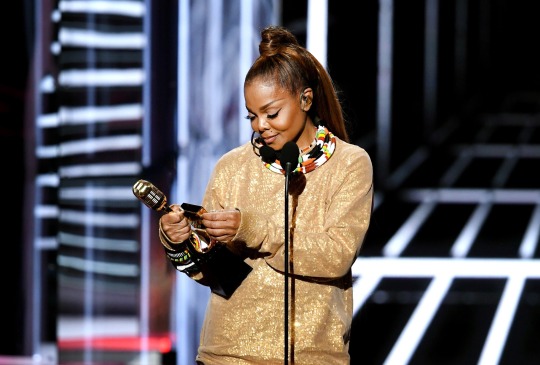
And how can we possibly forget Janet’s ICONIC performance and INSPIRING speech while accepting the Billboard Icon Award in 2018? The artist took the stage, offering the audience one of the fiercest and most impeccable performances ever of Nasty meshed up with When We Ooo (at the end of the song) and Throb. The singer also sought inclusivity not just with words; indeed, the performance featured a collective of dancers of all sizes, colors, and shapes. Eventually, Janet, introduced by Bruno Mars, graced the audience with an incredibly inspiring and beautiful acceptance speech: “I am deeply humbled and grateful for this award. I believe that for all the challenges, for all our challenges, we live at a glorious moment in history. It’s a moment when at long last, women have made it clear that we will no longer be controlled, manipulated, or abused. I stand with those women and with those men equally outraged by discrimination who support us in heart and mind. This is also a moment when our public discourse is loud and harsh.”. What a beautiful, stunning, inspiring queen!!
Furthermore, this summer 2020, the artist was supposed to start her Black Diamond world tour, but unfortunately, it has been postponed.
With this said, through her extraordinary career, Janet has proved so much and has achieved so much. Her unbelievable work ethic and talent have brought her to become one of the best artists on earth, and this is a fact. Her inspiring music celebrating women, especially African American women, impeccable choreographies, the iconic music videos celebrating, and uplifting black people have paved the path for many artists. With her vast contribution not just in the music business, Janet has become a legendary icon to many women and men. All hail to the queen.
Thank you for your attention💜 G.✨
#janet jackson#janet#janet damita jo jackson#janetjackson#rhythm nation#nasty boy#control#black artist#black female artists#female power#intersectional feminism#feminist#music#music icon#black excellence#iconic#article#poetic justice#michael jackson#damitajo#velvet rope#all for you#unbreakable
159 notes
·
View notes
Text
BLACK FARMERS TO BUY FROM INSTEAD OF WHOLE FOODS
ATLANTA
Boxcar Grocer
Patchwork City Farms
Truly Living Well Center for Natural Urban Ag
BALTIMORE
Five Seeds Farms
The Flower Factory
The Greener Garden
CHICAGO
Healthy Food Hub
Trinity United Church of Christ Farmers Market (Summer)
Your Bountiful Harvest Family Farm
CLEVELAND
Chateau Hough Vineyard
Rid-All Green Partnership
DMV
Afroculinaria
Community Farming Alliance
Good Sense Farm
Three Part Harmony
OAKLAND
Afrika Town Community Garden
Farms to Grow, Inc.
People’s Grocery
Phat Beets Produce
DETROIT
D-TownFarm
KENTUCKY
Barbour’s Farm LLC
LOS ANGELES
The Ron Finley Project
Sola Food Co-op
South Central Farmers’ Cooperative
PHILADELPHIA
The Philadelphia Urban Creators
Mill Creek Farm
NYC
Black Urban Growers
La Familia Verde
The BLK ProjeK
East New York Farms
PHOENIX
Tiger Mountain Foundation
SAN DIEGO
City Heights Farmers Market
SOUTHEASTERN US
Southeastern African American Farmers’ Organic Network
VIRGINIA
Vanguard Ranch Natural Gourmet
NORTH CAROLINA
Pine Knot Farms (Hillsborough
22K notes
·
View notes
Photo



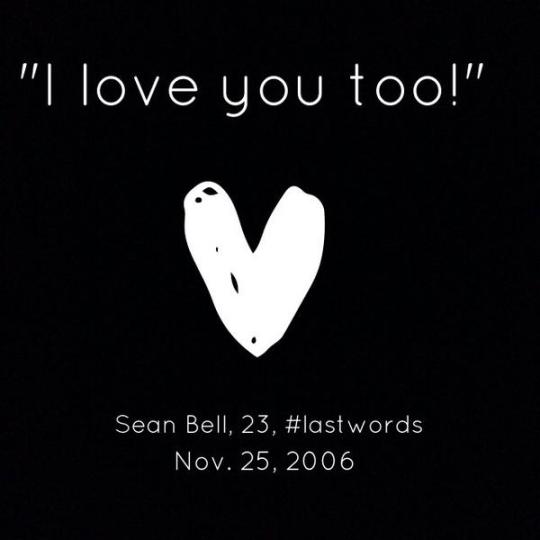


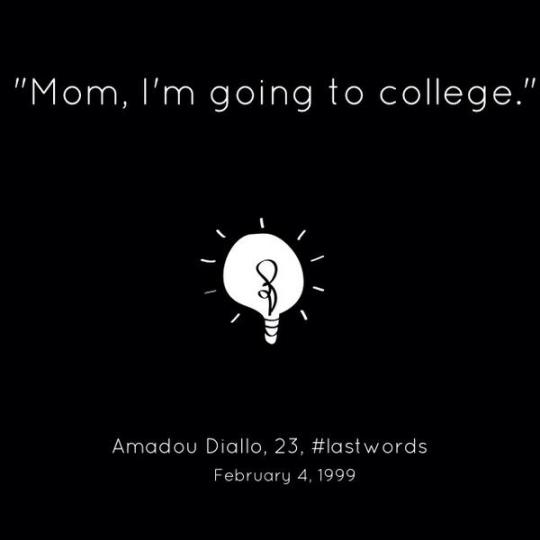

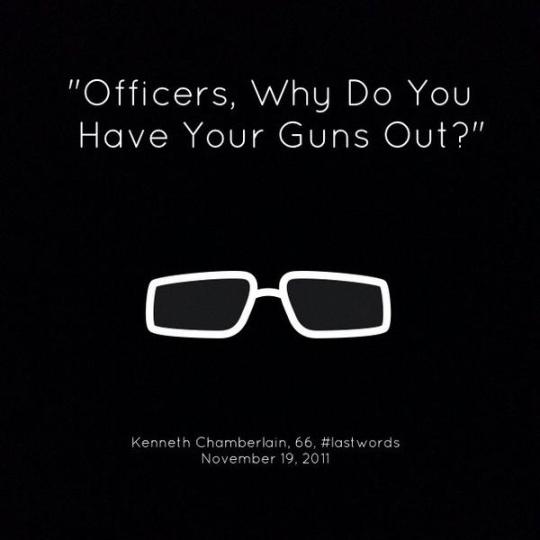
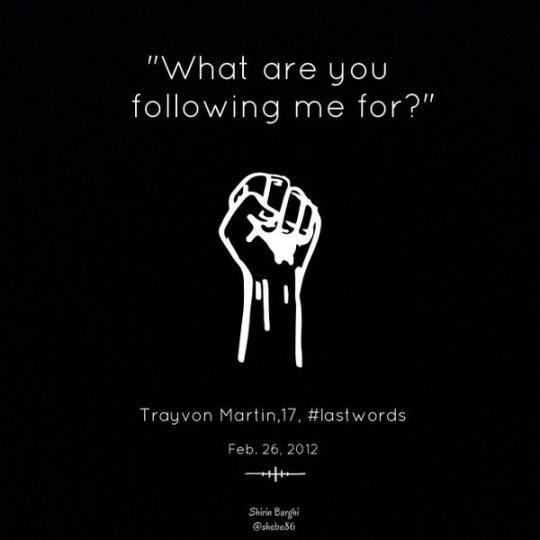
Potent minimalist art sends a strong message about police and vigilante brutality in America
Journalist and artist Shirin Barghi has created a gripping, thought-provoking series of graphics that not only examines racial prejudice in today’s America, but also captures the sense of humanity that often gets lost in news coverage. Titled “Last Words,” the graphics illustrate the last recorded words by Brown and other young black people — Trayvon Martin, Oscar Grant and others — who have been killed by police in recent years.
Let us not forget their voices
629K notes
·
View notes
Text
After all I’ve done for you...
....
You’ve played your game, but you’ve played yourself
.....
Watch me walk right through that door💁🏻♀️
...
YOU’RE DISMISSED!!
#janet jackson#janetjackson#janet damita jo jackson#music#music icon#music blog#black excellence#iconic#reblog#this time#janet#albums still matter
1 note
·
View note
Text
PARLIAMENT FUNKADELIC: MOTHERSHIP CONNECTION. HISTORY OF THE AFRO-FUTURISTIC PILLAR AND CLASSIC WE ALL NEED TO LISTEN TO


1975 and 1976 were two of the most prolific years for the intergalactic funk band, the Parliament-Funkadelic. The band released its 5th album Mothership Connection in 1975 and the sequel, The Clones of Dr. Funkenstein, only seven months later.
Mothership Connection was created as an act of protest given the conditions of systemic racism, oppression, and inequity that African-American people were experiencing. The release of Mothership Connection led Parliament to begin their US tour where the fans could live one of the most unique experiences ever.
The masterpiece was one of the highest and most significant manifestations of Afrofuturism, that is to say, the black and ultra-technological phenomenon. This vision was unfindable in movies or literature nor in politics during the late 70s. Indeed, the assertion of a black worldview that incorporated modern technologies and black aesthetics was a profound breakthrough.
Furthermore, the satirical-veiled social commentary and political critique became the signature-quirk of the album and ultimately of the band. In fact, the leader of the group, George Clinton, rather than openly critiquing political leaders, used humor and parody to propose a black counter-hegemony. That is to say, a new Post-Civil Rights movement form of black politics and black social organization that would provide an accessible alternative to the dominant middle-class white world, as African American people were suffering and barely surviving in!
Additionally, the uniqueness of the science fiction the album is featuring, contributes to creating a series of picturesque parallel universes. During the 70s, this work became hugely crucial for the African-American community because the band expressed and put into music the struggles for freedom that black people were feeling, especially young teenagers. This peculiar version of black science fiction was delivering a powerful message. In fact, due to the deteriorating of many black neighborhoods, the P-Funk galaxy was perceived as an escape. Almost as an act of flying away to some better worlds or universes.
Interestingly enough, the end of the song Mothership Connection (Star Child), consists of a quirky fusion with the spiritual work song Swing Low Sweet Chariot. The ribbon that ties the 1970s Mothership to the Chariot is, therefore, the meaning and purpose of the two songs. The spiritual Swing Low Sweet Chariot was adopted by the anti-slavery movement Underground Railroad in the 19th century. Whenever slaves heard this chant, they would know they had to be ready to escape. The Underground Railroad (Sweet Chariot) was coming south (Swing Low) to take the slaves to the north for freedom (carry me home). Hence, the historical connection between Parliament's Mothership and the Underground Railroad's Chariot is considerably apparent now: both the songs were aiding African American people to overcome racism and oppression. In the first case, the Charriot was meant to free black people from the condition of slavery. In the second case, the Mothership's purpose was to give a chance to African-American people of escaping, at least mentally, from the constraints of an oppressive and racist society. Besides, the symbolic meaning of the Mothership, related to the action of flying away, is being free and liberating the minds and the bodies from the everyday travails.


Furthermore, the leader of the band, George Clinton, believed in this project strongly enough to convince Casablanca Records President Neil Bogart to fund the costs of the tour around the country, in enormous halls and Arenas, which eventually attracted the most massive audience.
During the show, the group offered some of the most emblematic moments in music history. Indeed, the landing of the Mothership became an utterly iconic groundbreaking number of the concert. As displayed in some videos, the arrival of the spaceship usually took place at the end of the show after the song Mothership Connection. The spacecraft appeared and flew over the audience and then landed on stage with the bandleader, George Clinton, emerging from the space vehicle disguised as Dr. Funkenstein. Furthermore, Parliament-Funkadelic shows, through the elaborate artwork, the sci-fi mythology, and the Afrofuturist universe, offered the attendees an uplifting escape from their everyday struggle.


However, the Mothership used on stage during the 70s was later donated by George Clinton to the Smithsonian's National Museum of African American History and Culture. Furthermore, it is not a mystery that the spacecraft held a powerful and symbolic meaning. According to the museum specialist Kevin Strait:" He really developed this grand idea of envisioning African-Americans in space as a way to liberate one's mind from the shackles of racism and poverty or any other societal constraints,"…. "The Mothership was this symbolic mode of transporting the conscious self into this ethereal place, which was pretty funky and pretty far out, but represents the grander scope of his thinking.". In addition to that, the man himself, George Clinton gave an explanation on the importance of the message delivered by the Mothership "I definitely felt we needed something to be proud of as black people,"…" We wanted to have a funk opera.". The artist then explained how he saw the spaceship as a monument to black music, and therefore he decided to donate it to the museum so that eventually it would give pride to a lot of people.
This being said: may to the Mothership free your minds and your asses will follow
Thank you for your attention💜✨ G👽
#parliament funkadelic#parliament#pfunk#p funk#mothership connection#mothership#george clinton#music#music icon#musicians#black excellence#history#music history#the 70s#protest music#protest#no justice no peace#social critique#humor#satirical#music blog#reblog#article#great artists#dr funkenstein#funkmusic#afrofuturistic#afrofuturism#all time classic
140 notes
·
View notes
Text
THE HARLEM RENAISSANCE: THE BLOSSOMING OF JAZZ AND BLACK FEMALE ARTISTS
Hi, my music lovers; since yesterday, I mentioned the Harlem Renaissance, today I wanted to talk to you a bit about this relevant movement. Of particular importance was the role, Black female artists during the Renaissance. I chose to write about the perspective of African American women because they are very often neglected, misrepresented, and they are denied the importance, the relevance, the voice they HAVE ALWAYS deserved to have. The time to unveil all that they have gone through has finally come. I hope this article will give you the chance to reflect, I also hope you could learn something new through these words. I hope to do justice to those beautiful, special, amazing, strong black women who were usually neglected, denied of their voices, misrepresented, subjected to a systematic racist and sexist society. I hope to do them justice. I hope to be helpful in this attempt to spread some information and education. With this said: I hope you enjoy the essay💜
#black female artists#bessie smith#feminism#intersectional feminism#women empowering woman#empowering women#female power#black lives are important#black lives matter#educateyourself#history#music history#music blog#article#music#black excellence#reblog#female artists#st louis blues#short movie#great artists
21 notes
·
View notes
Text
Focusing on Prince and the song Avalanche: Lesson learned or....??


Hi my music lovers, today we are celebrating the birthday of the undisputed music legend and virtuoso: Prince Rogers Nelson. Since all that is happening these days, I wanted to offer you guys the chance to reflect on these crucial issues. Therefore I chose to focus only on one song in Prince's vault: Avalanche. In my opinion, this piece is quite relevant to what is happening these days. I really hope I do Prince justice. I hope we can learn something from this article and the lesson Prince taught us. Should there be anything, I missed do not think twice to let me know or contact me. Enjoy the article.
In 2002, Prince released One Nite Alone (Solo Piano and Voice by Prince). As the title suggests, the only accompaniment in this album is the piano. Today I want to offer you the chance to reflect on the song Avalanche. Avalanche. The message delivered with this song is compelling, and the lyrics were magistrally written. Moreover, as many people know, Prince was an avid reader and an extremely educated person who had a vast knowledge not only about music but also about history, in this case. Indeed, with these words, the Artist is referring to some historical events to create one of the most MONUMENTAL protests songs in music history. Before I explain this total MASTERPIECE, I need to mention some crucial points. I will never stress enough about this. We all know that Prince was a black man. However, the fact that he, in some interviews, said things like "I was brought up in a black and white world. Black and white, night and day, rich and poor. I always said that one day I was going to play all kinds of music and not be judged for the color of my skin, but the quality of my work" or quoting his song Controversy "I wish there was no black or white" etcetera... It does not mean he was not conscious and aware or proud of being black. This does not mean that he was not aware of what black people had and still have to endure and go through. Indeed, Prince was extremely knowledgeable of everything that I mentioned, and he was proud of being black, and this is something significantly present in his music, in his sense of style, in his words, lyrics, music videos, concerts, and movies. I'm making this point because I have overheard too many people accusing Prince of not embracing his blackness or even being biracial as the new york times erroneously claimed. None of these things are true. I also heard that the Artist was not aware of what black people had and still are going through and that his music was not "politicized enough." This is another big fat lie. This song is proof. Therefore, before writing and describing this MONUMENTAL song, I thought I needed to re-emphasize this significant point. By the way, Prince's mother was NOT Italian. She was a beautiful black woman. Furthermore, as already mentioned, Artist had extensive historical knowledge and was also conscious and aware of how black people have always been exploited and treated. Moreover, Prince was accustomed to speaking his mind and saying what he meant, and just by reading the superlative and poignant lyrics, we could see that the Artist was quite straight-forwarded in writing this piece. Indeed:
He was not or never had been in favor
Of setting are people free
If it wasn't for the thirteenth Amendment
We woulda been born in slavery
He was not or never had been in favor
Of letting us vote, so you see...
Abraham Lincoln was a racist who said
"You cannot escape from history "Like the snow comin' down the mountain
That landed on Wounded Knee
Nobody wants to take the weight
The responsibilityHear the joyous sound of freedom
The Harlem Renaissance
Hear Duke Ellington and his band
Kick another jungle jam
Ooh, do you wanna dance?
Who's that lurking in the shadows?
Mr. John Hammond with his pen in hand...
Sayin' "Sign you're kingdom over to me
And be known throughout the land!"
But, you ain't got no money, you ain't got no cash
So you sign yo name, and he claims innocence
Just like every snowflake in an avalanche...Like the snow comin' down the mountain
That landed on Wounded Knee
Nobody wants to take the weight
The responsibility

This masterpiece begins with a quote taken from the 4th Lincoln-Douglas debate held in Charleston, South Carolina, on September 18, 1858. Lincoln opened his discussion with these words:
"While I was at the hotel to-day, an elderly gentleman called upon me to know whether I was really in favor of producing a perfect equality between the (slur) and white people. [Great Laughter.] While I had not proposed to myself on this occasion to say much on that subject, yet as the question was asked me, I thought I would occupy perhaps five minutes in saying something regarding it. I will say then that I am not, nor ever have been, in favor of bringing about in any way the social and political equality of the white and black races, [applause]-that I am not nor ever have been in favor of making voters or jurors of (slur), nor of qualifying them to hold office, nor to intermarry with white people. I will say in addition to this that there is a physical difference between the white and black races, which I believe will forever forbid the two races living together on terms of social and political equality. And since they cannot so live, while they do remain together there must be the position of superior and inferior, and I as much as any other man is in favor of having the superior position assigned to the white race."
This was just the beginning of the speech Lincoln gave, and the words bolded are the exact beginning of the song by Prince (disclaimer: I replaced the racial slurs with this (slur) since I do not want any slurs on my platform). Moreover, as we can see in this song, the Artist was calling out the former President Abraham Lincoln for being racist. As you can see from this speech, HE REALLY WAS A RACIST. Moving on with the speech, Lincoln also said that he was not against slavery, and therefore he did not want to abolish it. Additionally, Prince mentioned the thirteenth Amendment. Before I report the Amendment, I believe it is important to contextualize it. What I am about to write will show one more time that Lincoln was a stone-cold racist, unlike many people were taught in schools. So, during the Civil War, the South USA (which economy was unfortunately still based on slaves working in plantations), wanted to keep a balance of free and slave states to maintain its political power in Congress. Southern slaveholders feared the loss of control for many reasons, including a rational fear that if Northern abolitionists had eventually swayed their representatives to vote to abolish slavery, the South wouldn't have had the votes to stop it. So, on September 22, 1862, President Lincoln warned the Confederate states that if they did not rejoin the Union before January 1, 1863, he would free their slaves. If they had timely surrendered, he would not have issued the Emancipation Proclamation. Therefore, on January 1, 1963, Lincoln "proclaimed" the "end of slavery." Bear in mind that this was as much an act of political/military strategy rather than moral courage.
Additionally, the Emancipation Proclamation freed only slaves held in the eleven Confederate states that had seceded, and only in the portion of those states not already under Union control. Slavery was left untouched in the loyal border states. The Proclamation also expressly exempted parts of the Confederacy (the Southern secessionist states) that had already come under Northern control. Most important, the freedom it promised depended upon the Union (United States) military victory. The actual abolition of slavery was achieved when the Thirteenth Amendment was ratified on December 6, 1865. The first section of the Amendment declares, "Neither slavery nor involuntary servitude, except as a punishment for crime where of the party shall have been duly convicted, shall exist within the United States, or any place subject to their jurisdiction.". In addition to everything mentioned, the second segment of the speech I bolded is about the right to vote. Eventually, the Artist ends these verses accusing Lincoln of being racist, saying that it is not possible to escape from history. I must say that Lincoln really was A RACIST, and we have always been taught history the wrong way. I also must say that despite the abolition of slavery, black people were never really free, for racism was and still is one of the biggest plagues not just in the USA but all over the world and what we have seen until now is the proof.

Moreover, in the next verses, the Artist mentioned the Harlem Renaissance. For those who do not know that was, I will give a quick explanation of it. The Harlem Renaissance was a cultural, literary, and intellectual movement that fostered a new black cultural identity. This movement flourished in Harlem, New York, after World War I and ended around 1935 during the Great Depression. The movement raised significant issues affecting the lives of African Americans through various forms of literature, art, music, drama, painting, sculpture, movies, and protests. Voices of demonstration and ideological promotion of civil rights for African Americans inspired and created institutions and leaders who served as mentors to aspiring writers. The Harlem Renaissance arose from a generation that had lived through the gains and losses of Reconstruction after the American Civil War. Sometimes the parents or grandparents of those who lived during that historical period were slaves. Many people who lived in the Harlem Renaissance were part of the Great Migration. They moved out of the South into the black neighborhoods of the North and Midwest of the USA. African Americans sought a better standard of living and relief from the institutionalized racism in the South. Others were people of African descent from racially stratified communities in the Caribbean who came to the United States hoping for a better life. Uniting, most of them were their convergence in Harlem, New York City. Furthermore, Harlem was the center of a musical evolution that uncovered amazing talents and created a unique sound that had yet to be paralleled. Jazz was the newest sound, and it attracted both blacks and whites to go to nightclubs like the Savoy Ballroom to hear artists like Duke Ellington, Billie Holiday, and Miles Davis. Jazz was a result of the Harlem Renaissance, which originated from the musical minds of extraordinarily talented African American people. The genre includes traits that survived from West African American music, black folk music forms developed in the New World. In his song, Prince was indeed referring to jazz music and one of its most relevant and most brilliant artists: Sir. Duke Ellington. In the next lines, we see the Artist mentioning John Hammond. Hammond was a white talent scout, record producer, and music critic. This is another excellent example of how history has been distorted. Indeed, if you look upon the net, you will find that this man fought against segregation and racism. However, if you read Frank Kokofsky's book, John Coltrane and the Jazz Revolution of the 1960s, you will learn the truth about the political economy of white domination over black music. In particular, Kokofsky focuses on the relationship between John Hammond, Columbia Records, and the Artist Bessie Smith. Indeed, as Kokofsky writes:
"The first and most important point to emphasize is that, as author Chris Albertson reveals in his biography of Bessie Smith, Hammond signed the singer to a series of contracts with Columbia Records that gave her a small, fixed fee for each performance she recorded and no royalties. Such contracts were apparently standard practice with the executive, for Billie Holiday unequivocally stated in her autobiography, Lady Sings the Blues: 'Later on John Hammond paired me up with Teddy Wilson and his band for another record session. This time I got thirty bucks for making half a dozen sides.' When she protested about this arrangement, it was, according to her, a Columbia executive named Bernie Hanighen – and not John Hammond – 'who really went to bat for me' and 'almost lost his job at Columbia fighting for me.'"
Hear the joyous sound of freedom
The Harlem Renaissance
Hear Duke Ellington and his band
kick another jungle jam
Ooh, do u wanna dance?
Who's that lurking in the shadows?
Mr. John Hammond with his pen in hand...
sayin' "Sign ur kingdom over 2 me
and b known throughout the land!"
But, u ain't got no money, U ain't got no cash,
So u sign yo name and he claims innocence
just like every snowflake in an avalanche.
This situation is quite familiar, isn't it? Perhaps Prince had heard or read about this, and therefore he decided to add this fact to this masterpiece.
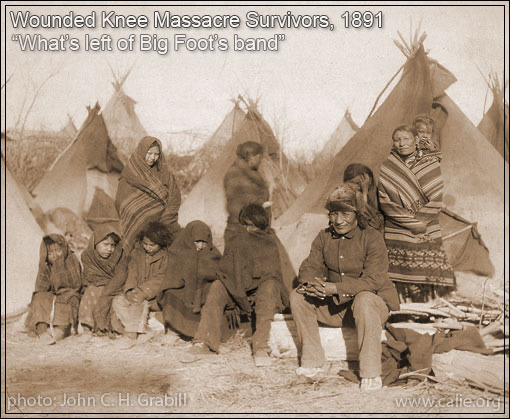
Last but not least, another relevant part of this song is the chorus. Indeed, with this brilliantly written chorus, Prince is referring to the massacre of Wounded Knee, where more than 350 Native-American were killed. Indeed, On the morning of December 29, 1890, Chief Spotted Elk (Big Foot), leader of a group of some 350 Minneconjou Sioux, sat in a makeshift camp along the banks of Wounded Knee Creek. The group was surrounded by U.S. troops sent to arrest him and disarm his followers. The atmosphere was tense since an order to arrest Chief Sitting Bull at the Standing Rock Reservation just 14 days earlier had resulted in his murder, prompting Big Foot to lead his people to the Pine Ridge Agency for a safe haven. Alerted to the band's Ghost Dance activities, General Nelson Miles commanded Major Samuel Whiteside and the Seventh Cavalry to apprehend Big Foot and his followers, and the regiment intercepted them on December 28, leading them to the edge of the creek. While confiscating their weapons, a shot pierced the brisk morning air. Within seconds the charged atmosphere erupted as the Indian men rushed to retrieve their seized rifles, and troopers began to fire volley after volley into the Sioux camp. From a hill above, a Hotchkiss machine gun raked the tipis, gun smoke filled the air, and men, women, and children ran for a ravine near the camp, only to be cut down in the crossfire.
More than 200 Lakota laid dead or dying in the aftermath, as well as at least 20 soldiers. Although the story of the Wounded Knee Massacre is well-known, its causes and effects are still an enigma 125 years later. For 19th century Americans, it represented the end of Indian resistance and the conquest of the West. For Native-American, it represented the utter disregard of the U.S. toward its treaty responsibilities, its duplicity, and its cruelty toward Native people. In the 20th century and beyond, Wounded Knee continued to fuel controversy and debate. Notably, what is particularly controversial was and is the impetus and intent of the government that day, the role of the military, and the conflicting ways the tragedy is remembered today. Indeed, from this story, we can see how Prince gave his listener another example of how racism was a persistent plague.
Like the snow comin' down the mountain
that landed on Wounded Knee
Nobody wants 2 take the weight-
The responsibility
Moreover, as I said, the Artist with this MAGISTRALLY written lyrics educates his listener on how racism has always been a persistent, prominent, outraging, and horrifying plague that is still going on today. In addition to that, we can notice Prince's deep and broad historical knowledge, which is something incredibly fascinating and mesmerizing. Moreover, the arrangement of this song, the instrumental and the vocal delivery is among the finest and most poignant he has ever done. Indeed, the Artist with this masterpiece delivers an extraordinarily intimate and intense but yet POWERFUL performance. In my opinion, even though the only instrument played is the piano, its arrangement is outstandingly complex. The blues genre the Artist opted for, also could not have been more following the whole meaning and purpose of the song. Furthermore, the Artist's incredibly broad vocal techniques are perfectly accompanying the meaningful message of the song. Prince, with his ability to shift from a beautiful falsetto to an extremely low chest voice to eventually change to a powerful head voice during the last chorus, is putting into sounds magistrally and vividly a poignant lesson we are still struggling to learn.
Thank you for your attention.💜 Peace. G💜
#prince#princerogersnelson#prince rogers nelson#prince nelson#purple family#purple royalty#the purple one#avalanche#one nite alone#piano and microphone#music#music icon#black excellence#protect black lives#black lives are important#lies we’re told studying history#history#black lives matter#truth#article#reblog#genius#protest#protest songs#against racism
144 notes
·
View notes

